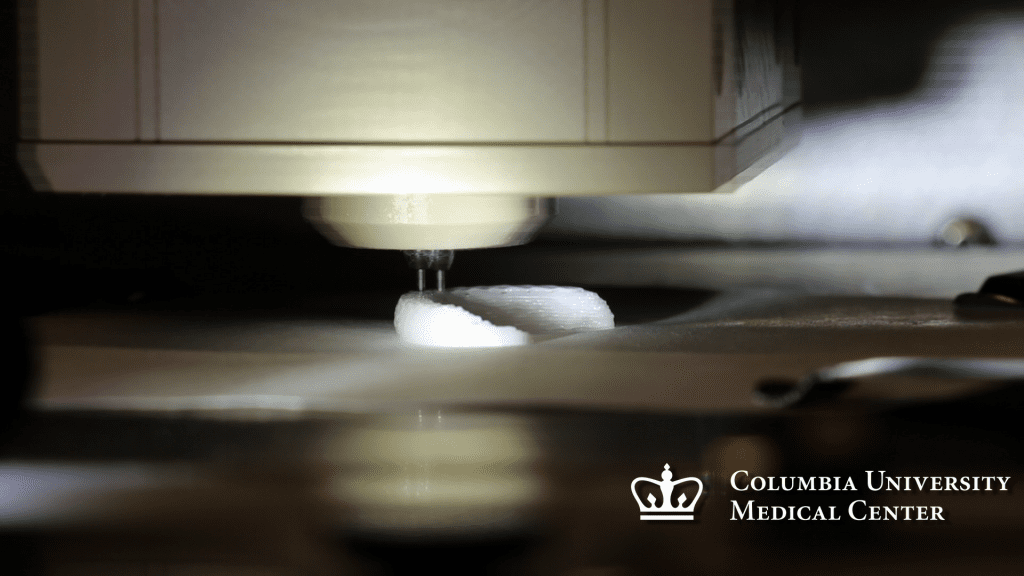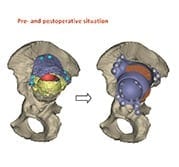
3D-printing of the knee meniscus scaffold.
Personalized scaffold promotes tissue regeneration in sheep
Columbia University Medical Center researchers have devised a way to replace the knee’s protective lining, called the meniscus, using a personalized 3D-printed implant, or scaffold, infused with human growth factors that prompt the body to regenerate the lining on its own. The therapy, successfully tested in sheep, could provide the first effective and long-lasting repair of damaged menisci, which occur in millions of Americans each year and can lead to debilitating arthritis. The paper was published today in the online edition of Science Translational Medicine.
“At present, there’s little that orthopedists can do to regenerate a torn knee meniscus,” said study leader Jeremy Mao, DDS, PhD, the Edwin S. Robinson Professor of Dentistry (in Orthopedic Surgery) at the Medical Center. “Some small tears can be sewn back in place, but larger tears have to be surgically removed. While removal helps reduce pain and swelling, it leaves the knee without the natural shock absorber between the femur and tibia, which greatly increases the risk of arthritis.”
A damaged meniscus can be replaced with a meniscal transplant, using tissue from other parts of the body or from cadavers. That procedure, however, has a low success rate and carries significant risks. Approximately one million meniscus surgeries are performed in the United States each year.
Dr. Mao’s approach starts with MRI scans of the intact meniscus in the undamaged knee. The scans are converted into a 3D image. Data from the image are then used to drive a 3D printer, which produces a scaffold in the exact shape of the meniscus, down to a resolution of 10 microns (less than the width of a human hair). The scaffold, which takes about 30 minutes to print, is made of polycaprolactone, a biodegradable polymer that is also used to make surgical sutures.
The scaffold is infused with two recombinant human proteins: connective growth factor (CTGF) and transforming growth factor ?3 (TGF?3). Dr. Mao’s team found that sequential delivery of these two proteins attracts existing stem cells from the body and induces them to form meniscal tissue.
For a meniscus to properly form, however, the proteins must be released in specific areas of the scaffold in a specific order. This is accomplished by encapsulating the proteins in two types of slow-dissolving polymeric microspheres, first releasing CTGF (to stimulate production of the outer meniscus) and then TGF?3 (to stimulate production of the inner meniscus). Finally, the protein-infused scaffold is inserted into the knee. In sheep, the meniscus regenerates in about four to six weeks. Eventually, the scaffold dissolves and is eliminated by the body.
The Latest on: 3D-Printed Implant
[google_news title=”” keyword=”3D-Printed Implant” num_posts=”10″ blurb_length=”0″ show_thumb=”left”]
via Google News
The Latest on: 3D-Printed Implant
- A Guide to 3D Printing for Healthcare, Today and Tomorrowon May 9, 2024 at 10:02 am
The technology is used by many health systems to create custom implants and models, but how will it be used in medicine as it advances?
- Europe 3D Printing in Healthcare Market CAGR of 22.3%, Power of Data Visualization Techniques for Communicating Research Findingson May 8, 2024 at 2:27 am
and the rising adoption of 3D printed medical implants, medical devices and bio printed organoids. Highlighted with 41 tables and 71 figures, this 134-page report “3D Printing in Healthcare: Europe ...
- 3D Systems Receives FDA Clearance for 3D Printed VSP PEEK Cranial Implantson May 6, 2024 at 9:00 am
D Systems has recently secured FDA clearance for the world's first 3D printed PEEK Cranial Implant, offering improved patient-specific care.
- 3D printed surgical implants may support cures for blindness, chronic pain and neurological diseaseson April 29, 2024 at 12:17 pm
Clever bio-inks that sit inside the human body and restore damaged neurons could cure a whole swathe of diseases in the next 20 years: conditions that have baffled scientists and clinicians for ...
- 3D printers are helping surgeons create custom cranial implantson April 26, 2024 at 11:28 am
I know that if I suffer a severe injury, especially to my skull, all I really need is a 3D printer. Now that I’m in my 40s, I’m more acutely aware of the inherent risk of injury in normal, everyday ...
- Global 3D Printed Medical Implants Industryon April 23, 2024 at 8:06 am
Global 3D Printed Medical Implants Industry is projected to reach worth of US$ 2,494.5 million by 2032, expanding at a CAGR of 12.5% by 2032 ...
- FDA Approves Innovative 3D-Printed Cranial Implants for US Market Entryon April 16, 2024 at 7:04 pm
The Food and Drug Administration (FDA) has made history by approving the entry of 3D-printed cranial implants into the US market. This groundbreaking decision follows the successful use of these ...
- 3D Systems obtains 510(k) clearance for 3D-printed cranial implantson April 16, 2024 at 10:41 am
The patient-specific implant includes the EXT 220 MED 3D printer and represents a significant advancement in cranial reconstruction technology. It is said to be the world's first FDA-cleared ...
- In a first, FDA approves 3D-printed cranial implants to enter USon April 16, 2024 at 10:41 am
A firm called 3D Systems has devised a patient-specific cranial implant solution called “VSP® PEEK Cranial Implant.” This implant aims to restore defects in the skull via cranioplasty procedures.
- 3D-printed PEEK-based Cranial Implants Cleared by FDAon April 15, 2024 at 5:00 pm
3D Systems has received 510(k) clearance from the US Food and Drug Administration (FDA) for its 3D-printed, patient-specific cranial implant system. The VSP PEEK Cranial Implant includes a complete ...
via Bing News











